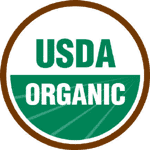Fit and Fast Recipes
Understanding Organics: Labeling & Certification
What is organic certification?
The certified organic label is the consumer’s guarantee the product has been produced according to the USDA's specific national standards for farmers and food handling organizations.
All these standards must be met for certification:
- A public or private certifying organization conducts annual inspections of farms and food handlers and periodic testing of soil and water to verify that a farm meets or exceeds defined standards.
- Organic farmers are required to keep detailed records of purchases and practices, which inspection agencies examine systematically. All farmers and handlers are also required to maintain written organic management plans.
- Most farms are required to farm organically for at least three years before the food they produce can be labeled certified organic. An exception to this rule are farms that have not been growing organic products for the past three years, but that have not used unapproved chemicals during that time either. All farms, however, must have been under the supervision of a certification agency for the past 12 months before producing food that can be labeled certified organic.
- No prohibited substances may be applied to the land during that period.
- Not more than 5% of any organic-labeled processed food may contain non-organic ingredients (excluding water and salt).
How can I tell whether food has met the USDA's national standards for organic food?
Along with the national organic standards, the USDA has developed strict new labeling rules to help consumers know the exact organic content of the food they buy. The USDA organic seal, increasingly common after October 2002, indicates a product is at least 95% organic.

The USDA label may appear on stickers on the packaging, outer skin, or display signs for single-ingredient foods such as produce, milk, meat, eggs, or cheese.
Use of the seal is voluntary, however, farmers who knowingly sell a product labeled organic that fails to meet USDA standards can be fined up to $10,000 for each violation.
What about foods with more than one ingredient?
There are four categories for organic foods with more than one ingredient. The first three categories prohibit any ingredients produced using genetic engineering, irradiation, or sewage sludge.
- 100% organic: Only products that have been exclusively produced using organic methods carry this label.
- Organic: At least 95% of the ingredients (by weight, excluding water and salt) in products carrying this label must be organically produced.
- Made with organic: Products with 70 to 95% organic ingredients may display “Made with organic [with specific ingredient or ingredients listed]” on the front panel.
- Less than 70% organic: Products with less than 70% organic ingredients may list these specific items in the ingredient panel.
The actual percent of organic content may be displayed on all products, regardless of label category. However, the rule specifies the actual dimensions that are allowed in displaying the content, and, as noted earlier, the percentage for products with less than 70% organic ingredients can only be displayed in the information panel. In all four labeling categories, the product cannot use both organic and non-organic versions of the same ingredient.
Note that labels may also make other truthful claims about their food content, such as “natural,” “free-range,” and “hormone-free,” but these claims are not interchangeable with “organic.” For more on organic meat labeling, see Understanding Organics: Meat & Poultry.
Ausubel K. Seeds of Change: The Living Treasure. San Francisco: Harper, 1994.
Barry W. The Pleasures of Eating. In: Clark R, ed., Our Sustainable Table. San Francisco: North Point Press, 1990.
Community Alliance with Family Farmers. Summaries of State Organic Laws. National Organic Directory, 1996, 193–205.
Environmental Working Group, Same As It Ever Was, 1996.
Harmony report, “Pesticides: Losing their Effectiveness”.
The Hartman Report, Food and the Environment: A Consumer’s Perspective, Phase I, Bellevue, WA, 1996, 23; Phase II, Bellevue, WA, 1996, 17.
Natural Business, “1998 Financial Market Overview.”
National Organic Program Overview, www.ams.usda.gov/nop/facts/overview.htm
National Research Council. Pesticides in the Diets of Infants and Children. 1993;June:2.
Organic Trade Association, “Frequently Asked Questions About the U.S. Organic Standards,” 1999.
Organic Trade Association, “Questions and Answers About Organic,” 1999.
Organic Trade Association, “Standards Will Benefit Consumers,” What’s New in Organic Newsletter Mar/Apr 2001.
Organic Trends, “U.S. Organic Regs Proposed for the Year 2000,” Winter 1998.
Pesticide and Toxic Chemical News, May, 1998.
Wall Street Journal, “And the Organic Oscar Goes To...,” September 17, 1999.
Waters A. The Farm-Restaurant Connection. In: Clark R, ed., Our Sustainable Table. San Francisco: North Point Press, 1990.










